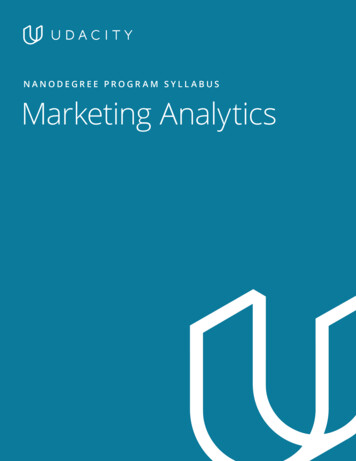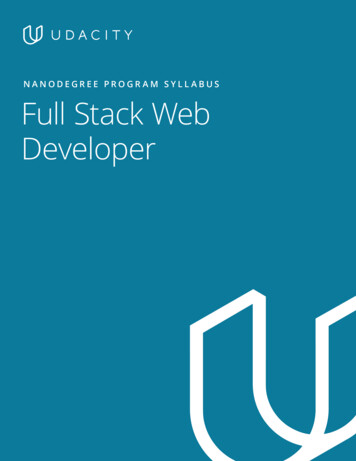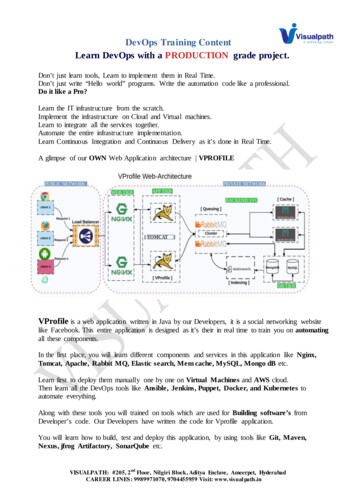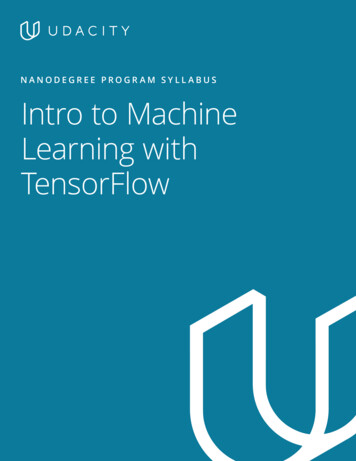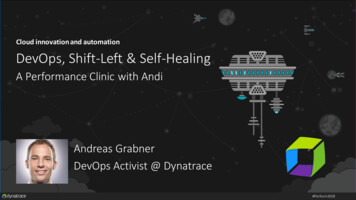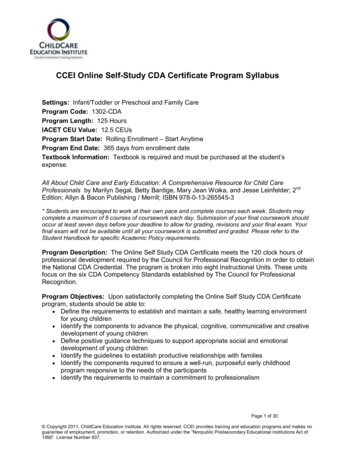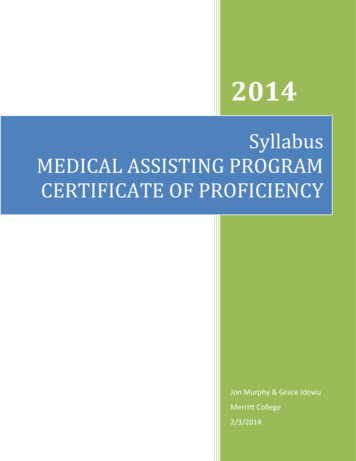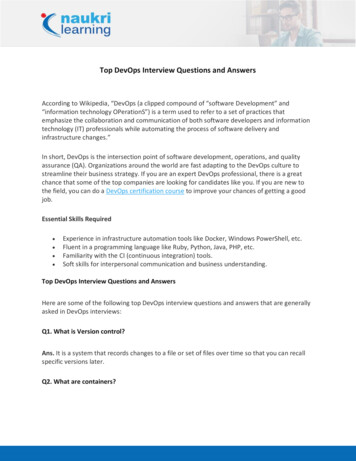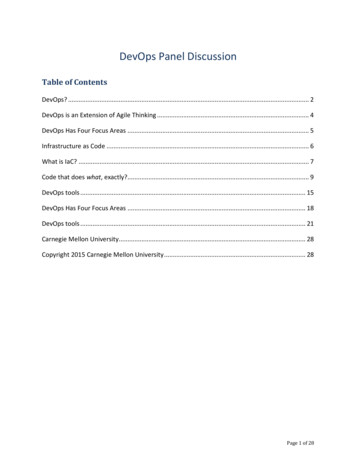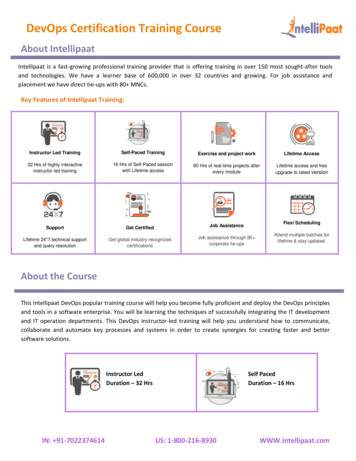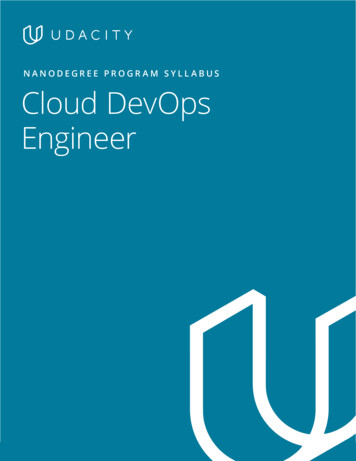
Transcription
NANODEGREE PROGR AM SYLL ABUSCloud DevOpsEngineerNeed Help? Speak with an Advisor: www.udacity.com/advisor
OverviewCompanies are looking for talented DevOps engineers to remain competitive in this agile world. Enroll nowto operationalize infrastructure at scale and deliver applications and services at high velocity, an essentialskill for advancing your career. Learn to design and deploy infrastructure as code, build and monitor CI/CDpipelines for different deployment strategies, and deploy scaleable microservices using Kubernetes.Estimated Time:4 Months at10hrs/weekPrerequisites:BasicProgramming andLinux CommandLineFlexible Learning:Self-paced, soyou can learn onthe schedule thatworks best for youNeed Help?udacity.com/advisorDiscuss this programwith an enrollmentadvisor.Need Help? Speak with an Advisor: www.udacity.com/advisorCloud DevOps Engineer 2
Course 1: Cloud FundamentalsThe cloud has become a key enabler for innovation with beneficial features like high availability, unlimitedcapacity, and on-demand scalability and elasticity. Learn the fundamentals of cloud computing while beingintroduced to compute power, security, storage, networking, messaging, and management services in the cloud.While learning the fundamentals, you will explore tools and services offered by Amazon Web Services (AWS)through interactive hands-on exercises. By the end of the course, you will have deployed your first website to AWS,and you will be prepared to continue your learning journey in the Cloud Developer Nanodegree program.Course ProjectDeploy Static Websiteon AWSThe cloud is perfect for hosting static websites that only includeHTML, CSS, and JavaScript files that require no server-sideprocessing. In this project, you will deploy a static website to AWS.First, you will create a S3 bucket, configure the bucket for websitehosting, and secure it using IAM policies. Next, you will upload thewebsite files to your bucket and speed up content delivery usingAWS’s content distribution network service, CloudFront. Lastly, youwill access your website in a browser using the unique S3 endpoint.LEARNING OUTCOMESLESSON ONELESSON TWOLESSON THREECloud Overview Learn the basics of cloud computing including clouddeployment models, benefits, and popular options Explore services provided by Amazon Web Services(AWS)Foundational andCompute Services Learn why we need servers, compute power, and security Explore AWS compute services like Elastic Cloud Compute(EC2), Virtual Private Cloud (VPC), Lambda for serverlessframework, and Elastic Beanstalk in action Launch a secure EC2 instance, create and execute aLambda, and deploy an application to Elastic BeanstalkStorage and ContentDelivery Learn why we need storage and content delivery in thecloud Learn storage services like S3, DynamoDB, RelationalDatabase Service (RDS), and CloudFront Create a DynamoDB table, launch a MySQL databaseinstance, and create a CloudFront distributionNeed Help? Speak with an Advisor: www.udacity.com/advisorCloud DevOps Engineer 3
LESSON FOURSecurity Learn the importance of security in the cloud See Identity & Access Management (IAM) in action Secure applications using IAM users, groups, and policiesLESSON FIVENetworking &Elasticity Learn the basics of networking and elasticity in the cloud Examine services like Route 53, EC2 Auto Scaling, andElastic Load Balancing Add an auto scaling policy to your EC2 instanceMessaging &Containers Learn the basics of messaging and containers in the cloud Explore services like Simple Notification Service (SNS),Simple Queue Service (SQS), and Elastic Container Service(ECS) Create cloud notifications using SNSAWS Management Learn why we need logging, auditing, and resourcemanagement in the cloud Understand services like CloudWatch, CloudTrail,CloudFormation, and the AWS Command LineInterface (CLI) Explore the CLILESSON SIXLESSON SEVENNeed Help? Speak with an Advisor: www.udacity.com/advisorCloud DevOps Engineer 4
Course 2: Deploy Infrastructure as Code (IAC)With the advent of cloud computing, along came several tools that enabled us to deploy the underlyinginfrastructure components that provide security and services to our servers by writing scripts. In this course,you’ll learn how to deploy this infrastructure using CloudFormation, AWS’ tool for Infrastructure as Code.You will use CloudFormation to deploy Infrastructure patterns that are used broadly in the industry andcan be readily used to deploy any cloud application. Like in the real world, you will begin with initial businessrequirements that you will turn into Cloud Architecture Diagrams. Then, you will deploy this architecture usingCloudFormation.Course ProjectDeploy a High-AvailabilityWeb App UsingCloudFormationIn this project, you’ll deploy web servers for a highly available webapp using CloudFormation. You will write the code that creates anddeploys the infrastructure and application for Instagram-like appfrom the ground up. You will begin with deploying the networkingcomponents followed by servers, security roles, and software. Theprocedure you follow here will become part of your portfolio ofcloud projects. You’ll do it exactly as it’s done on the job: followingbest practices and scripting as much as possible.LEARNING OUTCOMESLESSON ONEGettingStarted withCloudFormation Set up the necessary tools to get started with CloudFormationand deploy your first server using CloudFormationLESSON TWOInfrastructureDiagrams Convert business requirements into infrastructure diagramsand understand the principles behind design choicesNetworkingInfrastructure Implement a virtual private network and subnets and learnhow to provide inbound and outbound internet access to yourpublic and private subnets inside your VPC Use routing table to route the traffic within your virtual privatecloudLESSON THREENeed Help? Speak with an Advisor: www.udacity.com/advisorCloud DevOps Engineer 5
LESSON FOURServers andSecurity Groups Deploy a web server into an autoscaling group Implement load-balancer to increase capacity of your app Implement security groups and understand the concept ofleast-privilege as it applies to network trafficLESSON FIVEStorage andDatabases Deploy S3 storage for images, config files, and more. Deploy relational database and encryption service for yourapplicationNeed Help? Speak with an Advisor: www.udacity.com/advisorCloud DevOps Engineer 6
Course 3: Build CI/CD Pipelines, Monitoring& LoggingIn this course, you’ll learn the process of taking software from source code to deployment and beyond.You’ll learn about automated testing, choosing the right deployment strategy for your business needs anddeploying an appropriate CI/CD pipeline. You’ll also learn about monitoring and logging to ensure that yourapplication is running at peak performance and stays that way.You’ll also learn to manage and make changes to your servers in an automated way, using Ansible, a leadingConfiguration Management tool.Course ProjectBuild CI/CD Pipeline forBlue/Green DeploymentIn this project, you will build on the skills acquired during this course.You will first create a pipeline that spins up three servers and usesAnsible to deploy an application on the servers. Once those serversare running, you will create another pipeline to confirm that serverswere configured as expected. You’ll then use the “Blue/Green”deployment strategy to deploy additional features to those servers.LEARNING OUTCOMESLESSON ONEConfigurationManagementwith Ansible Install software automatically with a tested and repeatableprocess that can be executed across your entire server fleet Apply patches to your infrastructure without having tomanage servers individuallyLESSON TWOBuild CI/CDPipelines withJenkins on AWS Select the appropriate deployment strategies to avoiddowntime Create pipelines that include automated testing to ensuresoftware packages are delivered with quality in mind Identify and create pipelines for development and productionLESSON THREELogging Use CloudWatch to aggregate logs Setup log agents to collect data directly from the source andsend it to a centralized location for analysisLESSON FOURMonitoring &Alarms Identify and monitor meaningful metrics Set up alarms that will alert you of potential server issues Create dashboards to visualize your server metricsNeed Help? Speak with an Advisor: www.udacity.com/advisorCloud DevOps Engineer 7
Course 4: Microservices at Scale Using KubernetesIn this course, you will learn to create and deploy a Kubernetes cluster, configure Kubernetes autoscale, andload test a Kubernetes application. You’ll learn to operationalize both existing and new microservices, andapply containers best practices. You’ll learn to deploy Machine Learning microservices that are elastic andfault tolerant. You’ll learn to pick the appropriate abstraction for microservices: Serverless (AWS Lambda) orContainer Orchestration (Kubernetes).Course ProjectOperationalize a MachineLearning Microservice APICourse ProjectCapstone ProjectIn this project, you will continue your work on operationalizingmicroservices by deploying an elastic and fault-tolerant MachineLearning inference API using Kubernetes. You’ll configure thismicroservice to be highly available by using Kubernetes bestpractices. You will validate your design by load testing the serviceand verifying the application architecture performs as designed.The purpose of the Cloud DevOps capstone project is to give you achance to combine what you’ve learned throughout the program.This project will be an important part of your portfolio that willhelp you achieve your cloud development-related career goals. Inthe capstone project, each project is unique to the student. You’llbuild a CI/CD pipeline for a microservices application for differentdeployment strategies. Students define the scope of the projectand select the right deployment strategy based on differentbusiness requirements.LEARNING OUTCOMESLESSON ONEDeploy HighavailabilityMicroservice EventDriven Application Understand Serverless (AWS Lambda) concepts Understand which container abstraction to use: AWSLambda or Kubernetes Deploy producer/consumer AWS Lambda applications Configure CloudWatch eventsLESSON TWOUse Docker FormatContainers Understand Docker image format Run and modify Docker containers locally Deploy customized containers to Amazon ECRNeed Help? Speak with an Advisor: www.udacity.com/advisorCloud DevOps Engineer 8
LESSON THREEContainerization ofExisting App Use the appropriate Docker base image Install packages into Docker image Copy application into Docker image Configure application setup and start in Docker imageLESSON FOUROperationalize &OrchestrateKubernetes Understand Kubernetes concepts Configure monitoring, alerts, and incidence response Integrate CI/CD Pipeline Configure AutoscalingNeed Help? Speak with an Advisor: www.udacity.com/advisorCloud DevOps Engineer 9
Our Classroom ExperienceREAL-WORLD PROJECTSBuild your skills through industry-relevant projects. Getpersonalized feedback from our network of 900 projectreviewers. Our simple interface makes it easy to submityour projects as often as you need and receive unlimitedfeedback on your work.KNOWLEDGEFind answers to your questions with Knowledge, ourproprietary wiki. Search questions asked by other students,connect with technical mentors, and discover in real-timehow to solve the challenges that you encounter.WORKSPACESSee your code in action. Check the output and quality ofyour code by running them on workspaces that are a partof our classroom.QUIZZESCheck your understanding of concepts learned in theprogram by answering simple and auto-graded quizzes.Easily go back to the lessons to brush up on conceptsanytime you get an answer wrong.CUSTOM STUDY PLANSCreate a custom study plan to suit your personal needsand use this plan to keep track of your progress towardyour goal.PROGRESS TRACKERStay on track to complete your Nanodegree program withuseful milestone reminders.Need Help? Speak with an Advisor: www.udacity.com/advisorCloud DevOps Engineer 10
Learn with the BestKesha WilliamsAlfredo DezaI N S T R U C TO RI N S T R U C TO RKesha has over 20 years experience insoftware development and is a softwareengineering manager at Chick-fil-A,routinely leading innovation teams inproving out the use of cloud services tosolve complex business problems. Shewas recently named an Alexa Championby Amazon.Alfredo is a passionate software engineer,avid open source developer, Vim pluginauthor, photographer, and formerOlympic athlete. He has rebuilt companyinfrastructure, designed shared storage,and replaced complex build systems,always in search of efficient and resilientenvironment.Carlos RivasOlin WreadI N S T R U C TO RI N S T R U C TO RCarlos is a Senior Solutions Architectat Infinity Consulting where he helpsinstitutions move traditional data centersto the cloud. He has worked for severallarge telecommunication providersmanaging and configuring networkinfrastructure, using Java, Groovy, Python,Perl, and PHP.Olin is a Senior DevOps Engineer at FigureEight. He has over 13 years of experiencein a variety of DevOps, Systems Engineer,and Systems Administration roles atcompanies such as Heartflow, Netgear,and Turnitin. Outside work, he enjoysphotography and spending time with hisdaughter.Need Help? Speak with an Advisor: www.udacity.com/advisorCloud DevOps Engineer 11
Learn with the BestNoah GiftI N S T R U C TO RNoah has worked at companies includingDisney Feature Animation, SonyImageworks, Weta Digital, and AT&T. Heis a lecturer at universities includingNorthwestern, UC Berkeley and UC Davis.He is the author ofNeed Help? Speak with an Advisor: www.udacity.com/advisorCloud DevOps Engineer 12
All Our Nanodegree Programs Include:EXPERIENCED PROJECT REVIEWERSREVIEWER SERVICES Personalized feedback & line by line code reviews 1600 Reviewers with a 4.85/5 average rating 3 hour average project review turnaround time Unlimited submissions and feedback loops Practical tips and industry best practices Additional suggested resources to improveTECHNICAL MENTOR SUPPORTMENTORSHIP SERVICES Questions answered quickly by our team oftechnical mentors 1000 Mentors with a 4.7/5 average rating Support for all your technical questionsPERSONAL CAREER SERVICESC AREER SUPPORT Resume support Github portfolio review LinkedIn profile optimizationNeed Help? Speak with an Advisor: www.udacity.com/advisorCloud DevOps Engineer 13
Frequently Asked QuestionsPROGR AM OVERVIE WWHY SHOULD I ENROLL?The Cloud Computing field is expected to continue growing rapidly over thenext several years, and there’s huge demand for DevOps engineer acrossindustries. In fact, DevOps Engineer topped LinkedIn’s “Most recruited jobs”list in 2018.Udacity has collaborated with industry leaders to offer a world-class learningexperience so you can become a DevOps Engineer. You’ll get hands-onexperience building CI/CD pipelines using Jenkins, deploying infrastructureusing code, implementing configuration management using Ansible, deployingmicroservices at scale, and more. You’ll have personalized support as youmaster in-demand skills that qualify you for high-value jobs in the cloudcomputing field.By the end of the program, you’ll have an impressive portfolio of real-worldprojects, and valuable hands-on experience. You’ll also receive career supportvia profile and portfolios reviews to help make sure you’re ready to establish asuccessful devops career, and land a job you love.WHAT JOBS WILL THIS PROGRAM PREPARE ME FOR?This program is designed to prepare people to become devops engineers.This includes job titles such as DevOps Engineer, Reliability Engineer, ReleaseManager, and more. Obtaining the skills required to be a DevOps will make youextremely valuable across many industries, and in many roles. As a graduateof this program, you’ll be prepared to seek out roles that run the gamut fromgeneralist to specialist, and all points in between.HOW DO I KNOW IF THIS PROGRAM IS RIGHT FOR ME?If you’re a developer, system admin or operations manager interested inautomating IT infrastructure, building software delivery pipelines, anddeploying and managing infrastructure, this program is for you. Thisprogram will enable you to gain the skills necessary to succeed in thisrapidly-growing field.ENROLLMENT AND ADMISSIONDO I NEED TO APPLY? WHAT ARE THE ADMISSION CRITERIA?There is no application. This Nanodegree program accepts everyone,regardless of experience and specific background.Need Help? Speak with an Advisor: www.udacity.com/advisorCloud DevOps Engineer 14
FAQs ContinuedWHAT ARE THE PREREQUISITES FOR ENROLLMENT?To optimize your success in this program, we’ve created a list of prerequisitesand recommendations to help you prepare for the curriculum. To enroll, youshould have experience in the following: Basic knowledge of Linux Command Lines Basic understanding of any programming languageIF I DO NOT MEET THE REQUIREMENTS TO ENROLL, WHAT SHOULD I DO?We have a number of Nanodegree programs and free courses that can helpyou prepare, including: Intro to Computer Science Introduction to Python Programming Linux Command Line Basics Intro to Programming Nanodegree programTUITION AND TERM OF PROGR AMHOW IS THIS NANODEGREE PROGRAM STRUCTURED?The Cloud DevOps Engineer Nanodegree program is comprised of contentand curriculum to support 5 (five) projects. Once you subscribe to aNanodegree program, you will have access to the content and services for thelength of time specified by your subscription. We estimate that students cancomplete the program in four (4) months working 10 hours per week.Each project will be reviewed by the Udacity reviewer network. Feedback willbe provided and if you do not pass the project, you will be asked to resubmitthe project until it passes.HOW LONG IS THIS NANODEGREE PROGRAM?Access to this Nanodegree program runs for the length of time specified inyour subscription plan. See the Terms of Use for other policies around theterms of access to our Nanodegree programs.CAN I SWITCH MY START DATE? CAN I GET A REFUND?Please see the Udacity Nanodegree program FAQs for policies on enrollmentin our programs.S O F T WA R E A N D H A R D WA R E - W H AT D O I N E E D F O R T H I S P R O G R A M ?WHAT SOFTWARE AND VERSIONS WILL I NEED IN THIS PROGRAM?For this Nanodegree program you will need a desktop or laptop computerrunning recent versions of Windows, Mac OS X, or Linux and an unmeteredbroadband Internet connection.Need Help? Speak with an Advisor: www.udacity.com/advisorCloud DevOps Engineer 15
Learn the fundamentals of cloud computing while being introduced to compute power, security, storage, networking, messaging, and management services in the cloud. While learning the fundamentals, you will explor
